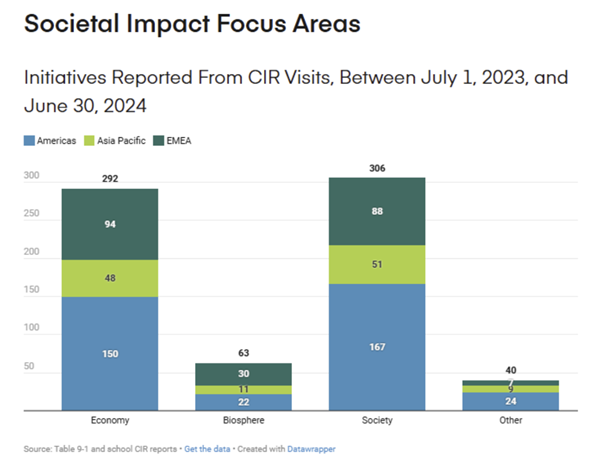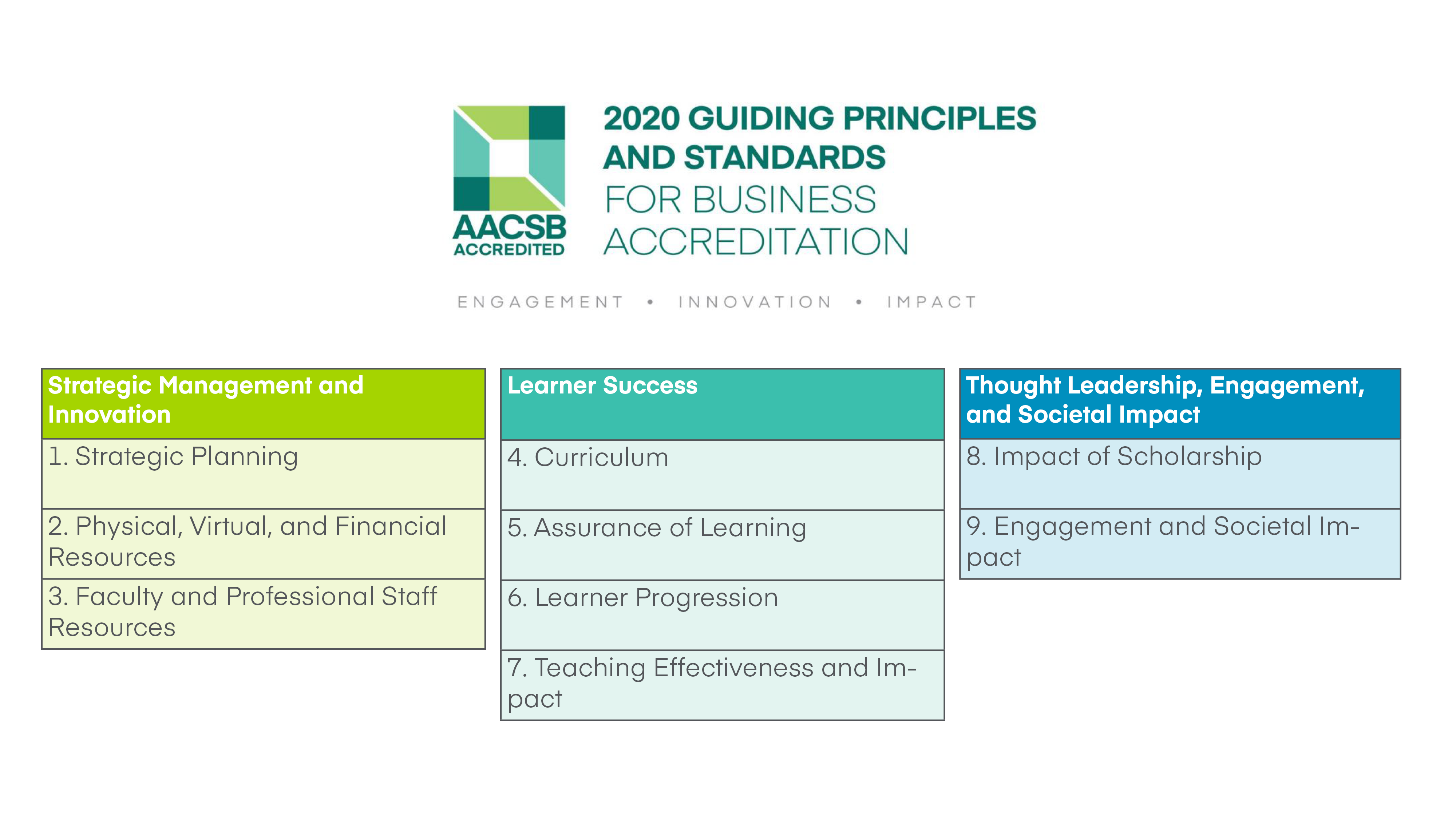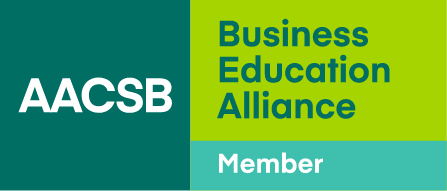
Business Accreditation
AACSB Business Accreditation Standards
In the spirit of continuous improvement, AACSB enhances the accreditation standards and interpretive guidance annually.
On February 28, 2025, AACSB released its annual update which took into consideration the legal and political environment surrounding higher education and accreditation and reframed terms that have become politicized in the U.S. and around the world. These changes to the 2020 Guiding Principles and Standards for Business Accreditation and Interpretive Guidance uphold our mission and values, while mitigating risks for our members. The technical edits also clarified that Scholarly Academic faculty are indeed expected to produce peer-reviewed journal articles as part of their portfolio of scholarship.
AACSB is proud to serve its diverse global network and has issued an open letter to clarify the intent, content, and implications of the recent changes.
AACSB makes annual technical updates to ensure clarity and relevance. These edits do not alter the standards proper (the bold text in green boxes), which fall under the purview of the Accreditation Council. However, all other parts of the standards document, including the Interpretive Guidance, are reviewed and updated by the Business Accreditation Policy Committee (BAPC) (see p. 7 of the standards document).
BAPC, which includes representatives from the Americas, Asia Pacific, and EMEA, ensures the standards reflect the needs of accredited schools worldwide. The latest version of the standards is effective February 28, 2025, and is available on our website.
- Revised language around diversity, equity, and inclusion (DEI) to reflect the evolving legal and regulatory landscape in the U.S.
- Clarification on scholarly academic (SA) status, specifying that faculty must publish peer-reviewed journal articles (PRJs) to maintain SA status. Previous language said faculty must publish peer-reviewed publications, so this is a clarification only, not a change in criteria.
The following table shows three examples of edits within the context of the interpretive guidance.
| Location | Previous Language | New Language |
|---|---|---|
| Standard 6-1, p. 17 | “The school actively seeks to attract and retain diverse learners consistent with AACSB Guiding Principle 9.” | “The school actively seeks to attract and retain learners with a range of backgrounds, experiences, and perspectives consistent with AACSB Guiding Principle 9.” |
| Philosophy, p. 8 | AACSB remains deeply committed to diversity and inclusion in collegiate business education. These values of diversity and inclusion foster the exploration of differences in a safe and supportive environment, where community members move beyond tolerance of differences to seeking and celebrating the rich dimensions of diversity and the contributions these differences make to innovative, engaged, and impactful business experiences. When business schools unlock access, reduce barriers, and intentionally create strategies to engage disadvantaged or underrepresented populations, they create an environment of success and enhance excellence. | AACSB remains deeply committed to fostering a vibrant and dynamic learning environment in collegiate business education. Encouraging the exchange of varied perspectives in a welcoming and engaging environment enriches the educational experience and prepares graduates to engage effectively in a global business landscape. When business schools expand opportunities and implement strategies to support broader participation, they cultivate an environment that drives success and strengthens excellence in business education |
| Guiding Principle 9, p. 17 |
Diversity and Inclusion. Diversity in people and ideas enhances the educational experience and encourages excellence in every business education program. At the same time, diversity is a culturally-embedded concept rooted in historical and cultural traditions, legislative and regulatory concepts, ethnicity, gender, socioeconomic conditions, religious practices, and individual and shared experiences. Within this complex environment, the school is expected to demonstrate a commitment to advancing diversity and inclusion issues in the context of the cultural landscape in which it operates. The school fosters awareness, understanding, acceptance, and respect for diverse viewpoints related to current and emerging issues. |
Community and Connectedness. A strong sense of community and meaningful connections enhance the educational experience and contribute to excellence in business education. Every institution operates within a unique cultural and historical context shaped by its traditions, societal influences, and regulatory environment. Schools are expected to cultivate an environment that values engagement, mutual respect, and collaboration among students, faculty, and stakeholders. By fostering awareness and appreciation of different perspectives, backgrounds, and experiences, schools prepare graduates to navigate complex global and professional landscapes with openness and understanding. |
.
We made changes to the interpretive guidance related to diversity and inclusion in response to a rapidly shifting legal and regulatory landscape in the United States. As an accreditor with a global membership, AACSB must balance our long-standing commitment to fostering positive societal impact and inclusive learning environments with the regulatory compliance needs of our member schools operating under different legal regimes. The revised terminology preserves our intent and expectations for inclusive excellence, while removing terms that have become legally constrained in certain jurisdictions.
As of February 27, 2025, the majority of U.S. states have enacted legislation restricting DEI-related initiatives. You can track developments through the Chronicle of Higher Education’s DEI Legislation Tracker. Notable examples include:
- Florida: SB 266 (2023), signed into law, prohibits the use of state or federal funds for DEI programs and restricts instruction that includes certain DEI-related topics in public institutions.
- Texas: SB 17 (2023), effective January 1, 2024, mandates the elimination of DEI offices, programs, and personnel in public institutions of higher education.
- Oklahoma: Executive Order 2023-31 (signed December 2023) prohibits state agencies, including public colleges and universities, from using public funds to support DEI offices, employee trainings, or related activities.
- Utah: HB 261 (2024) requires public universities to eliminate DEI-related positions and programs and prohibits compelled speech or trainings on DEI concepts.
These and similar laws in other states effectively placed public institutions in conflict with AACSB’s previous language. AACSB has received numerous inquiries from schools in these states expressing concern about potential risks associated with DEI language in accreditation standards. To support and protect our members and mitigate risk while staying true to our mission of elevating the quality and impact of business schools globally, AACSB removed or rephrased the terms "diversity" and "inclusion" and their derivatives from the standards.
Inherently, a school’s choice of focus area for societal impact is deeply personal to the school, and there are endless ways schools can use their business school skills and expertise to make a positive impact on society. That is the goal of the AACSB accreditation standards and in fact our vision for AACSB. We do not prescribe how a school chooses its focus area. Schools choose based on their mission, resources, and strategic plans. See the Interpretive Guidance for Standard 9 for some examples.
In our annual State of Accreditation Report, we share where schools who had accreditation visits are concentrating their societal impact efforts. Last year our schools reported 661 initiatives:

No. We have never had prescriptions around sustainability, ESGs, or the use of the SDGs in any place in the standards. Neither do we mandate the inclusion of specific topics such as sustainability or ESGs in the curriculum, as we respect the principle of academic freedom as relates to curricular content.
Many schools worldwide use the SDGs as a guide to their focus area with respect to Standard 9 and societal impact. Schools are welcome to use the SDGs but have never been required to do so. In the original 2020 standards, we say with respect to Table 9-1 and the SDGs, “The school may use the U.N. Sustainable Development Goals or a label of their choice to indicate their chosen focus area(s).” If a school does not want to use the SDG framework, they choose another identifier as their focus area for societal impact. The choice of how a school defines its impact has always been left to the institution.
Over time, as we decided on technical edits each year, we found that by explicitly including a list of the SDGs in various places, some people took that to mean they were required to use the SDG framework with respect to their societal impact. Since that was not the intent to require schools to use the SDGs, we removed the list from Table 9-1 in 2023 and further clarified that SDGs were optional. The most recent technical edits again reinforce school choice in this area.
Refreshing the AACSB Business and Accounting Accreditation Standards
Working in collaboration with members and stakeholders, the Standards Task Force is leading a thorough and inclusive process to examine how the standards can more effectively support business education worldwide. This work includes gathering input from the field, analyzing current and emerging trends, and identifying opportunities to improve clarity, relevance, and global applicability.
The standards fulfill the following key objectives:
- Reinforce long-held AACSB commitments to mission focus and peer review
- Emphasize a principles-based and outcomes-focused approach, as well as relevance for business schools now and in the future
- Recognize the changing landscape of student demographics and reflect the activities we envision business schools of the future will undertake to ensure continuous improvement and high quality in business education
- Elevate the importance of thought leadership in the context of a school’s mission.
- Characterize the guiding principles that represent key values to AACSB
The nine standards are organized into three categories:

For accounting accreditation standards, click here.





